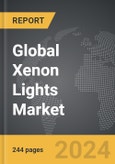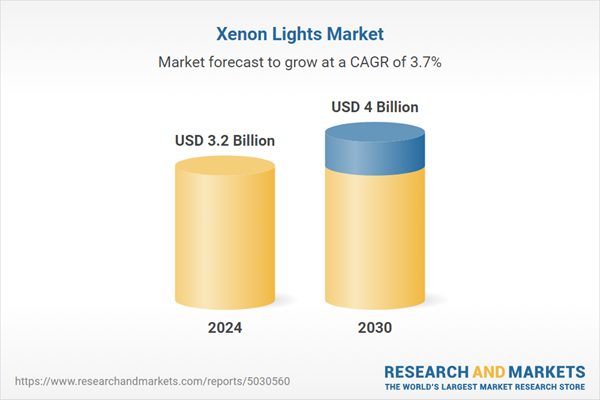Global Xenon Lights Market - Key Trends & Drivers Summarized
Why Are Xenon Lights Gaining Traction in Automotive and Aviation Industries?
Xenon lights, also known as high-intensity discharge (HID) lights, are increasingly gaining traction in the automotive and aviation industries due to their superior brightness, longevity, and energy efficiency compared to traditional halogen lamps. In automotive applications, xenon lights provide better visibility, enhancing safety during night driving and adverse weather conditions. This has led to a growing preference for xenon headlights among premium vehicle manufacturers and consumers who prioritize safety and performance. In aviation, xenon lights are used in runway lighting, signaling systems, and aircraft landing lights, where high intensity and reliability are crucial. The increasing adoption of xenon lights in these sectors is driven by the need for improved safety standards and the trend toward energy-efficient lighting solutions.What Technological Innovations Are Influencing the Xenon Lights Market?
Technological innovations are significantly influencing the xenon lights market, particularly in terms of performance and energy efficiency. The development of bi-xenon headlights, which provide both low and high beams in a single lamp, is gaining popularity among automotive manufacturers. Moreover, advancements in ballast technology have improved the energy efficiency and lifespan of xenon lights, making them a more sustainable option for both automotive and aviation applications. The integration of adaptive front-lighting systems (AFS) in vehicles, which automatically adjusts the direction and range of headlights based on vehicle speed and steering, is further enhancing the utility of xenon lights. These innovations are driving the adoption of xenon lights across various end-use sectors, expanding their market potential.How Are Environmental Regulations Shaping the Future of Xenon Lights?
Environmental regulations are shaping the future of xenon lights, particularly in terms of energy efficiency and the use of hazardous materials. While xenon lights are more efficient than halogen lamps, they still contain small amounts of mercury, which poses environmental risks. Stringent regulations in regions such as Europe and North America regarding hazardous substances and energy consumption are influencing manufacturers to innovate and develop mercury-free xenon lights or alternative technologies like LED and laser-based lighting. The ongoing shift toward sustainable and eco-friendly lighting solutions is a challenge for the xenon lights market, necessitating continuous innovation and adaptation to regulatory changes to maintain market competitiveness.The Growth in the Xenon Lights Market Is Driven by Several Factors
The growth in the xenon lights market is driven by several factors, including increasing demand for energy-efficient and high-performance lighting solutions in the automotive and aviation sectors, advancements in xenon light technology, and the growing adoption of adaptive lighting systems. The automotive industry's push for improved safety and visibility, especially in premium and luxury vehicles, is a significant driver for xenon headlights. The advancements in ballast and adaptive lighting technologies are also enhancing the appeal of xenon lights. Additionally, the expansion of aviation infrastructure and the need for reliable runway and aircraft lighting are contributing to the market's growth. However, environmental regulations and the rising competition from LED and laser technologies are also influencing market dynamics, shaping the future growth of xenon lights.Report Scope
The report analyzes the Xenon Lights market, presented in terms of market value (US$ Thousand). The analysis covers the key segments and geographic regions outlined below.- Segments: End-Use (Automotive Headlights, Theatre & Movie Projectors, Interior Lighting, Other End-Uses).
- Geographic Regions/Countries:World; United States; Canada; Japan; China; Europe (France; Germany; Italy; United Kingdom; Spain; Russia; and Rest of Europe); Asia-Pacific (Australia; India; South Korea; and Rest of Asia-Pacific); Latin America (Argentina; Brazil; Mexico; and Rest of Latin America); Middle East (Iran; Israel; Saudi Arabia; United Arab Emirates; and Rest of Middle East); and Africa.
Key Insights:
- Market Growth: Understand the significant growth trajectory of the Automotive Headlights End-Use segment, which is expected to reach US$1.8 Billion by 2030 with a CAGR of a 4.3%. The Theatre & Movie Projectors End-Use segment is also set to grow at 3.6% CAGR over the analysis period.
- Regional Analysis: Gain insights into the U.S. market, valued at $861.2 Million in 2024, and China, forecasted to grow at an impressive 6.1% CAGR to reach $822.7 Million by 2030. Discover growth trends in other key regions, including Japan, Canada, Germany, and the Asia-Pacific.
Why You Should Buy This Report:
- Detailed Market Analysis: Access a thorough analysis of the Global Xenon Lights Market, covering all major geographic regions and market segments.
- Competitive Insights: Get an overview of the competitive landscape, including the market presence of major players across different geographies.
- Future Trends and Drivers: Understand the key trends and drivers shaping the future of the Global Xenon Lights Market.
- Actionable Insights: Benefit from actionable insights that can help you identify new revenue opportunities and make strategic business decisions.
Key Questions Answered:
- How is the Global Xenon Lights Market expected to evolve by 2030?
- What are the main drivers and restraints affecting the market?
- Which market segments will grow the most over the forecast period?
- How will market shares for different regions and segments change by 2030?
- Who are the leading players in the market, and what are their prospects?
Report Features:
- Comprehensive Market Data: Independent analysis of annual sales and market forecasts in US$ Million from 2024 to 2030.
- In-Depth Regional Analysis: Detailed insights into key markets, including the U.S., China, Japan, Canada, Europe, Asia-Pacific, Latin America, Middle East, and Africa.
- Company Profiles: Coverage of players such as Abiomed, Inc., AtriCure, Inc., Aurora Group, Biosensors International Group Ltd., Biotronik SE & Co. KG and more.
- Complimentary Updates: Receive free report updates for one year to keep you informed of the latest market developments.
Some of the 42 companies featured in this Xenon Lights market report include:
- Abiomed, Inc.
- AtriCure, Inc.
- Aurora Group
- Biosensors International Group Ltd.
- Biotronik SE & Co. KG
- BioVentrix, Inc.
- GE Lighting
- HELLA GmbH & Co. KGaA
- Koninklijke Philips NV
- Magneti Marelli SpA
- OSRAM GmbH
- Stanley Electric Co., Ltd.
- Ushio America, Inc.
- Valeo SA
This edition integrates the latest global trade and economic shifts into comprehensive market analysis. Key updates include:
- Tariff and Trade Impact: Insights into global tariff negotiations across 180+ countries, with analysis of supply chain turbulence, sourcing disruptions, and geographic realignment. Special focus on 2025 as a pivotal year for trade tensions, including updated perspectives on the Trump-era tariffs.
- Adjusted Forecasts and Analytics: Revised global and regional market forecasts through 2030, incorporating tariff effects, economic uncertainty, and structural changes in globalization. Includes historical analysis from 2015 to 2023.
- Strategic Market Dynamics: Evaluation of revised market prospects, regional outlooks, and key economic indicators such as population and urbanization trends.
- Innovation & Technology Trends: Latest developments in product and process innovation, emerging technologies, and key industry drivers shaping the competitive landscape.
- Competitive Intelligence: Updated global market share estimates for 2025, competitive positioning of major players (Strong/Active/Niche/Trivial), and refined focus on leading global brands and core players.
- Expert Insight & Commentary: Strategic analysis from economists, trade experts, and domain specialists to contextualize market shifts and identify emerging opportunities.
Table of Contents
Companies Mentioned (Partial List)
A selection of companies mentioned in this report includes, but is not limited to:
- Abiomed, Inc.
- AtriCure, Inc.
- Aurora Group
- Biosensors International Group Ltd.
- Biotronik SE & Co. KG
- BioVentrix, Inc.
- GE Lighting
- HELLA GmbH & Co. KGaA
- Koninklijke Philips NV
- Magneti Marelli SpA
- OSRAM GmbH
- Stanley Electric Co., Ltd.
- Ushio America, Inc.
- Valeo SA
Table Information
| Report Attribute | Details |
|---|---|
| No. of Pages | 244 |
| Published | December 2025 |
| Forecast Period | 2024 - 2030 |
| Estimated Market Value ( USD | $ 3.2 Billion |
| Forecasted Market Value ( USD | $ 4 Billion |
| Compound Annual Growth Rate | 3.7% |
| Regions Covered | Global |









